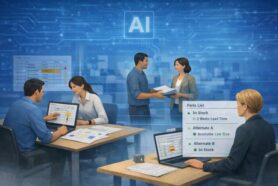
Manufacturing is all about creating products that meet customer needs. In order to do that, you need to design and build products using the right parts in the right quantities. This is when companies get their first exposure to the Bill of Materials (BOM). And this is where the first mistakes are usually made. A typical engineering approach is to pull a list of components to a spreadsheet and report that “the job is done”. BOM lists the individual components that make up a product, as well as how many of each component are needed. Sounds simple? Not so fast…
Excel – Easy To Start, Hard To Manage
One of the biggest challenges with the spreadsheet is an incredibly easy way to start using it. All CAD systems will allow you to export BOM to excel. As many engineers think that this is where their BOM problems will end. Not true…
To pull data from CAD design to Excel is not simple, because CAD design can be complex and might require an additional transformation of information before it will become useful for downstream purposes (think – planning, procurement, etc.). A very typical thing is to have data coming from multiple places – electronic, software, non-CAD objects. Quantity calculations, rollup and managing of item information in multiple bills – these are just first signs of difficulties.
To connect data is hard, but here is the next big challenge – how to manage the changes, revisions, approvals, purchases, etc. Pulling the entire process to Excel is an unmanageable task.
This is a place where we usually find many future OpenBOM customers – who struggle with Excel data management, not understanding how to make the next step. 95% of OpenBOM customers experience Excel struggles when trying to manage product information in Excel (or other forms of spreadsheets).
Import BOM – Why it is not that simple…
To import BOM to OpenBOM sounds very tempting once you got access to the OpenBOM account. You might think that pulling a BOM excel to OpenBOM solves the problem. While many things are easier in OpenBOM compared to Excel, it is not the first thing you should do.
The main reason is that when moving to OpenBOM from Excel, you’re changing the data management paradigm.
Although OpenBOM might look very similar to Excel and spreadsheets, it is not. The biggest difference is that OpenBOM is a data management and collaboration platform helping you to manage the data (not the document). And while importing the data, you should think about how to pull data to the right data management concepts used by OpenBOM – Item, BOMs, production, PO, etc. Check out OpenBOM data management training for more information.
Setting Data Import Priorities
The article 3 Steps To Move From BOM excels to manage product data in OpenBOM gives you an idea about what is the right sequence of data management planning and what needs to be done before actually importing the data.
Essentially, you need to follow these important steps:
- Define data management blocks that will be used to define the rest of the data. These are properties, Vendors, defining types of data – catalogs.
- Importing catalogs (or defining Items). This is one of the most important steps. You’re as strong as the item systems you created with the appropriate set of attributes.
- Import BOMs and other related information, setting initial baselines (revisions) if needed. BOMs are the final element in the hierarchy of product data, technically using Items (from catalogs) to define what to include in BOMs and how to structure them.
The importance of items is crucial. You need to think upfront about what type of data you will be managing – mechanical, electronics, mix, standard, fasteners, etc. Once you manage item and catalog creation, you create a data foundation for the rest of your products.
Check out more information in our training library. Also, keep in mind that OpenBOM premium onboarding process training is the time when we help you to plan your data model, catalogs, BOMs and define your data import strategy.
Conclusion
The quality of your data management processes is heavily dependent on how you define the data – items, catalogs, and all elements. Therefore, although it is very tempting to start importing the data right away, I’d encourage you to wait and do some planning before. Remember if you have a mess, don’t bring computers, because you will end up in a computerized mess. Do some data planning before – the ROI of this work will be amazing.
REGISTER FOR FREE to check out how OpenBOM can help you today.
Best, Oleg
Join our newsletter to receive a weekly portion of news, articles, and tips about OpenBOM and our community.










